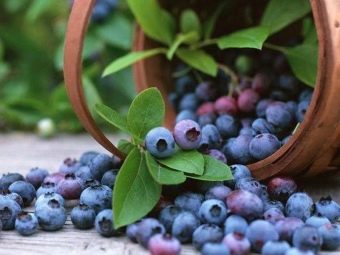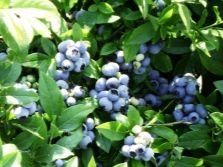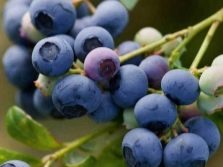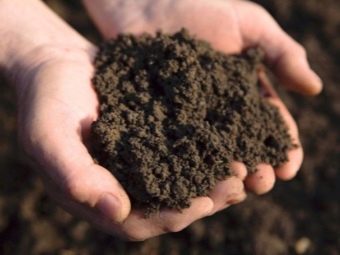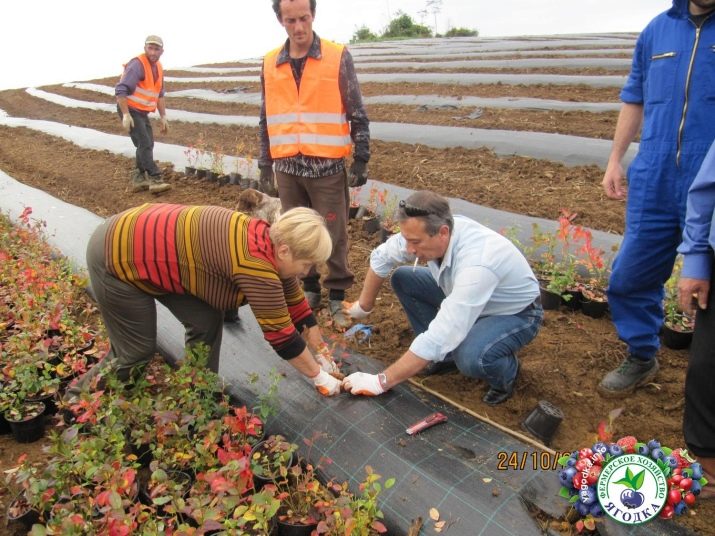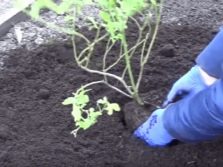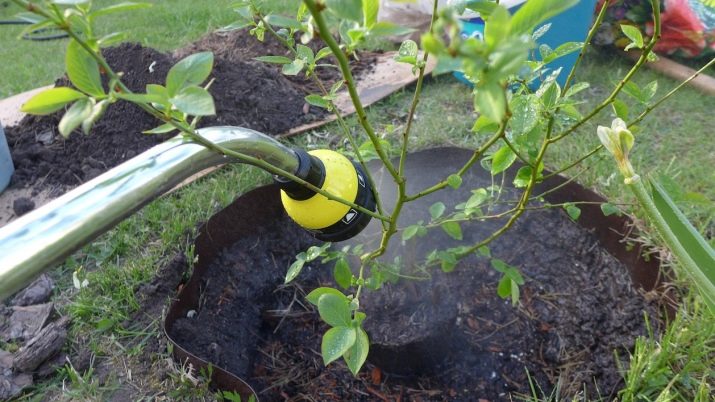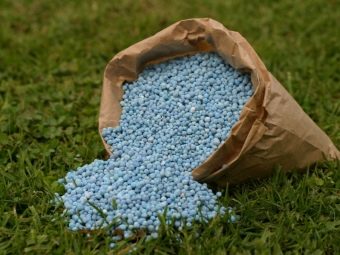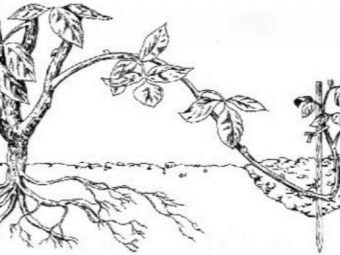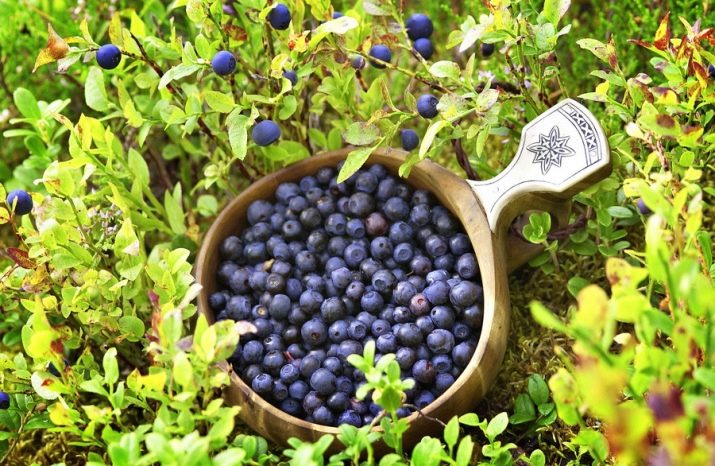Blueberry: planting and care in the Moscow region
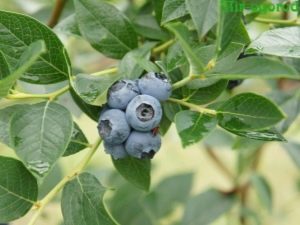
The northern blueberry berry is increasingly attracting the attention of gardeners, and it is quite clear why. With a pleasant taste, it contains a large amount of vitamins, in particular, C and PP, as well as mineral substances such as iodine, iron, magnesium, potassium, selenium.
Studies have shown that blueberries are good for the cardiovascular system, slows down the regressive processes in the brain, improves memory and attention. It also has a positive effect on digestion, it does not cause allergic reactions and can be recommended for feeding children. These berries do not accumulate heavy metals and are considered to be an environmentally friendly product.
Features of culture
Blueberries in the wild - a low shrub with small oval-shaped leaves. Fruits of blue color with a gray bloom have a sour taste with a slightly bitter taste. In people, the berry is also called shinika, drunkard and hemlock for frequent neighborhood with wild rosemary. Berry grows on marshy soils, to the growing conditions of unpretentious.
But it’s not worth transporting the plant from the forest to your dacha - most likely it will die quickly. It's all about saprophyte fungi, whose spores remain in the ground when digging out a bush. Without them, the plant on the garden plot is unlikely to take root.
Therefore, if there is interest in growing blueberries, you should pay attention to garden varieties. Cultivated plants are taller. If the wild fellows do not usually grow above 50 cm, then the garden can reach 1.5 and even 2 m, depending on the variety. With the help of selection, we managed to improve the taste and increase the yield. From one bush can collect up to 12 kg of berries.
Another important point: in the culture, blueberries begin to bear fruit for 2-3 years of life, whereas in nature - not earlier than the age of 15 years.
Types and characteristics
The most fruitful varieties of blueberry, suitable for growing in the Moscow region, are quite numerous, therefore, each of them should be given a separate description.
- Blucrop - tall variety. Free-form shrub forms shoots up to 1.9 m. Berries - up to 1.5 cm, slightly flattened, up to 9 kg can be harvested from a single plant. Ripening period - from late July to mid-August.
- Blue Ray - the variety is very fruitful, on average - 8 kg per bush. The berries are fragrant and large, more than 2 cm in diameter, bright blue. Harvest - at the end of July. The bush reaches a height of 1.8 m.
- Northland - variety is short, up to 1.2 m, but the bush is powerful and spreading, in yield is not inferior to tall - up to 8 kg from one plant. Berries - medium size with a small scar, sweet. Maturation - from mid-July.
- Northblue - large-fruited variety. The bush is powerful, low, 0.6–0.9 m in height. Harvest can be up to 2.5 kg from a bush, but stable. Berries up to 1.8 cm in diameter, with a dessert taste, dense, therefore suitable for long storage.
- Patriot - large-fruited variety, tall. The height of the bush is 1.2–1.8 m. The berries reach 1.9 cm in diameter, have an original, slightly bitter taste. Harvesting - from mid-July. You can get 5-7 kg of berries from one bush.
- Spartan - late-ripening variety, ripening - from mid-August. Bush tall, erect, up to 2 m tall. The berries are large, up to 1.6 cm, very fragrant, with a pleasant sour taste. Productivity is good - 4.5-6 kg per bush.
- Erliblyu - frost-resistant tall variety. The bush forms shoots up to 1.8 m in height. The berries are of medium size. Maturation - from mid-July. Productivity - up to 7 kg from a bush.
All of these varieties have a short growing season and are cold-resistant enough, which is necessary in order to successfully grow them in the suburbs.
An important condition: seedlings should be purchased from trusted suppliers and better in pots of soil. Maybe at the price it will turn out to be somewhat more expensive than cuttings, but the result will be more reliable. The root system must be closed.If the roots are open, it is likely that the plant will die quickly.
What climate is needed?
Blueberries - undemanding culture, so grow it in the Moscow dacha under the power of almost everyone, but you must comply with the following conditions:
- sufficient illumination;
- windproofness;
- soil moisture and acidity;
- good drainage.
Although blueberries are swamp dwellers, they cannot be called shade tolerant. Therefore, for planting you need to choose a lighted place, if possible - on the south side of the building. It is advisable to protect the bush from the wind fence or hedge. The soil should be acidic (Ph - 3.5–5) and moisture-permeable, since this plant does not tolerate water stagnation. Frosts up to 35 degrees, which are possible in the suburbs, blueberries survive quite capable under a thick layer of snow, so its branches are bent to the ground.
However, winters in central Russia often have little snow, and then it is better to cover the bushes. For this, any covering material that passes through the air is suitable, for example, a spanbond that is stretched onto a frame. Long shoots can freeze, and although they will recover in spring, this will reduce the future harvest.
Agrotechnology
When to plant?
You can plant blueberries in the ground in autumn or early spring, but spring planting is preferable (in the Moscow region - around mid-April). So the plant will have more time to gain strength for wintering.
If you still really need to land in the fall, it is recommended to do it no later than the beginning of October.
How to prepare the soil?
It is recommended to plant blueberries in pits or trenches filled with substrate. Since this culture forms powerful bushes with long shoots, the distance between them should be sufficient so that the plants do not overshadow each other (1–1.5 m between bushes and about 3 m between rows). The substrate should consist of soil with sand, peat and sphagnum peat, pine needles. You can add sawdust and cones.
Blueberry roots grow to 30 cm, which means that the pit for planting needs a depth of about 50 cm. The first layer should be drainage - small stones or expanded clay. Only after this does the prepared substrate fall asleep. Acquired plant with a pot should be placed in a container with water. After about half an hour, gently remove from the pot, slightly shake the roots off the ground and can be planted. Deep landing is not required.
If the soil on the plot is dense, loamy, you can plant blueberries in beds or fill ridges, but drainage is necessary in any case.
Plant care, care
A gardener needs to know the following:
- Temperature mode. Garden blueberries do not tolerate long-lasting heat very well, so if summer is sunny and dry, the plant will need a regular shower. Spray shrubs should be 2 times a day: morning and evening.
- Watering. While the seedling is taking root, the soil must be kept wet all the time, but without allowing waterlogging. Watering plants is necessary, even if the weather is wet in summer. In this case, 10 liters (buckets) of water for 1 bush 2 times a week will suffice. If there is heat and drought, daily watering will be required, and sometimes this procedure will have to be repeated 2 times a day. During the ripening of the fruit, it is also necessary to water more often, so that the berries are more juicy.
- Crop. Young bushes at the age of 1-3 years require only sanitary pruning. In early spring, you must inspect the plants and carefully cut the diseased and frozen branches. Anti-aging pruning should be carried out from the sixth year. 3-5 young strong shoots aged 1 or 2 years are left, given that the shrub should not be too thick. The rest cut out at the root.
- Pest and disease protection. To prevent diseases (moniliosis, white and double leaf spot, gray rot, stem cancer), the bushes should be treated with fungicides before flowering.With mycoplasma and viral diseases, the only way out, unfortunately, is the complete removal of the plant and the disinfection of the soil. Blueberry has few pests. During the period of bud swelling, the bushes can be treated with “Konfidor” and “Intavir”, then neither aphids nor tsvetoed will not be afraid of them. If there is a danger, after 2 weeks the treatment should be repeated. Flypicks and caterpillars that eat leaves and berries, you can simply collect hands.
- Weeding. Weeds are required to be removed regularly, eliminating competition for food and moisture. If gardening tools are used, it must be borne in mind that the roots of the blueberry are shallow, no more than 15–20 cm to the soil surface, therefore loosening the soil deeper than 10 cm may harm the plant.
- Top dressing. In no case it is impossible to feed blueberries with organic fertilizers, as this will greatly reduce the acidity of the soil. We need only mineral dressing, be sure to make nitrogen fertilizers. The first time is in April, before the buds swell, the second feeding should be done in mid-May, and the third until mid-June. Under each adult bush, 25–30 g of azofosca must be applied. Once in spring, blueberries should be supplemented with potassium and sulfur; 20 g of each substance are required for one bush.
The older and larger the plant, the greater the dose of fertilizer.
If you carefully monitor the development and appearance of blueberries, you can determine the need for certain mineral dressings:
- if the plant lacks phosphorus, the leaves rise and become reddish;
- growth retardation and yellow leaf indicate a lack of nitrogen;
- with a lack of magnesium, the edges of the leaves turn red;
- the blue color of young tops indicates boron deficiency;
- when there is not enough potassium, the tips of the leaves and branches turn black.
It remains only to make the necessary substance in a timely manner, and the plant will be healthy again.
Breeding
In the Moscow region, the most appropriate breeding methods are cuttings and layering.
For the first method, the material is harvested in late autumn. Shoots with 2-3 buds are cut. For a month they are placed in a cold place for stratification. For rooting, the same substrate is used, which is used when planting plants on the site (sand, riding and sphagnum peat, needles). To speed up the process of root formation, apply stimulants "Kornevin" or "Epin."
The container with cuttings is placed in a greenhouse or simply covered with a film, you only need to regularly ventilate and moisten the soil. Under all conditions, the roots are formed after 45 days, after which the plants are ready for planting in open ground.
In the second method, a strong shoot tightly pressed to the ground, you can fix it with a slingshot or wire loop. Place the pressure piled up with a thick layer of sawdust. It is important not to forget about moisture. At the same time, the root system of the future new bush will be formed for 2-3 years.
Harvesting
In order to lengthen the fruiting period, it is recommended to grow several varieties of blueberries with different ripening terms. How to determine whether the berries are ripe or not yet, is it time to harvest or should we wait? Of course, you can focus on color: the fruits turn blue - we collect. It is very pleasant to define on taste: the sweet berry has got - we put the others in a basket. However, not everything is so simple.
Usually, collecting the harvest, we hope that it will last a long time and will delight us in the fall and long winter. Suitability of fruits for storage due to the sugar content. Immediately after dyeing, the berries are sweet by 10%, that is, not at all sweet, and the flesh inside may turn out to be green and not at all soft. About a week later, the berries will be poured, the sugar content in them will reach 30% - then you can collect. This should be done in dry weather and better - with your hands, without using mechanical devices.
Wet and damaged fruits begin to deteriorate after 2–3 days, while correctly and timely harvested blueberries can be stored in a refrigerator at temperatures up to 0 degrees and relative humidity 90–95% to 6–10 weeks. Their freezing is possible. For home canning, these delicious berries are also great.
Timely harvesting is important not only for the quality of the berries, because over-ripening and long-term fruit on the bushes prevent the budding of flower buds of the next year.
Useful tips
Much has been said about the acidity of the soil, and this is a really important point. But even if you prepare the recommended substrate, the Ph-reaction may be higher than necessary (Ph up to 7 - acid reaction, 7 - neutral, above - alkaline). The fact is that the acidity of pure peat is about Ph - 6. The soil can be additionally acidified with a solution of a common battery electrolyte in the proportion of 1 ml per 1 liter of water. Other acids besides sulfuric acid are not recommended.
To facilitate weed control and prevent the soil from drying out, mulching can be used. It is better to do immediately after planting. For mulch, grass, needles, sawdust are suitable. When using the latter, it is necessary to double the amount of applied nitrogen fertilizers.
Reviews
In the responses of gardeners there is a keen interest in the cultivation of garden blueberries. Their experience shows that with the observance of agrotechnics, the proper care of shrubs, the use of the most suitable varieties for the region, it is possible to gather in the Moscow region big harvests of this tasty and healthy berries.
You will learn all about the features of planting blueberries in the Moscow region from the following video.





